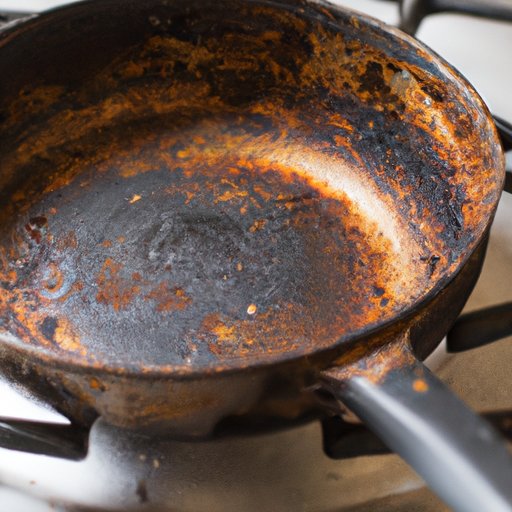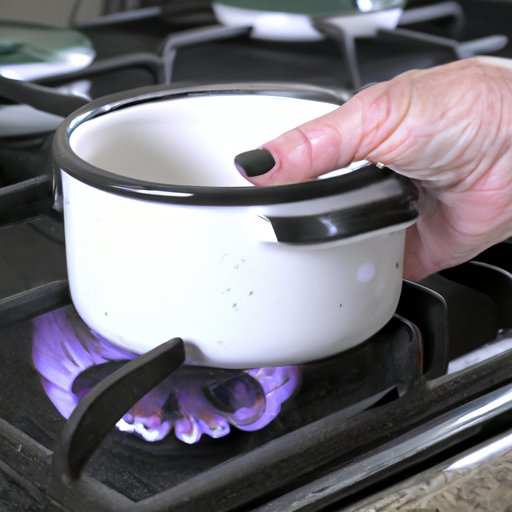
Introduction
Cooking is one of the most enjoyable activities one can indulge in. However, it often comes with the challenge of cleaning up burnt pots and pans. These cookware can become a pain to clean, especially when the burnt residue sticks stubbornly, and scrubbing only seems to worsen the situation.
This article has the sole purpose of providing readers with simple, effective, and safe solutions to clean their burnt cookware without causing further damage.
7 Simple Steps to Salvage Your Burnt Pots and Pans
Cleaning burnt cookware requires a specific technique to avoid ruining the pot or pan’s surface. The following steps can help you salvage your burnt cookware effectively:
Step 1: Let the Pot Cool Down Before Cleaning
Attempting to clean a hot pot or pan immediately leads to further burning and loss of flavor, making it more difficult to clean.
Step 2: Soak the Burnt Pot in Hot Water and Dish Soap
Start by filling the burnt pot or pan with hot water, add a few drops of dish soap, and let it soak overnight.
Step 3: Scrape off Any Remaining Burnt Food With a Spatula or Wooden Spoon
After soaking, begin by removing any remnants of food that got stuck on the surface using a spatula or wooden spoon. Avoid using any metal utensils, as this could scratch the surface.
Step 4: Use Baking Soda and Vinegar to Scrub off Tough Stains
Mix a paste by combining baking soda and vinegar and apply it to the burnt surface. Allow it to sit for a few minutes, then scrub gently with a non-abrasive scrubber.
Step 5: Try Using a Commercial Cookware Cleaner
If the burnt stain is stubborn, consider using a commercial cookware cleaner. Look for one that is non-abrasive and safe to use on the material of your burnt cookware.
Step 6: Use a Non-abrasive Scrubber to Remove Stubborn Stains
Once the burnt stain has loosened, you can use a non-abrasive scrubber like a kitchen sponge, to dislodge it.
Step 7: Rinse the Pot Thoroughly and Dry It With a Clean Towel
Rinse the pot thoroughly with running water and dry it with a clean towel. If the burnt stain persists, repeat the cleaning process.
The Ultimate Guide to Clean Burnt Cookware
Different types of cookware come with their cleaning requirements. Knowing how to clean each type of cookware effectively is crucial in salvaging them after they become burnt. Below are some tips to clean stainless steel, non-stick, and cast iron cookware.
Cleaning Tips for Stainless Steel Cookware
For stainless steel cookware, avoid using abrasive cleansers as they could damage the surface. Instead, use a non-abrasive cleaner like baking soda, which removes stains while keeping the surface intact.
Cleaning Tips for Non-stick Cookware
Non-stick cookware requires extra care to avoid damaging the non-stick surface. Avoid using sharp tools or abrasive cleansers and opt for a non-abrasive sponge while cleaning.
Cleaning Tips for Cast Iron Cookware
Cast iron cookware requires seasoning to maintain an even surface and improve durability and heat retention. To clean a cast iron pot or pan, use a non-abrasive scrubber and avoid using soap as it could affect the seasoning.
Address Common Questions and Concerns About Cleaning Burnt Cookware
While cleaning burnt cookware, several concerns may arise, such as residue left on the surface and potential damage to the material. This guide addresses these issues and offers effective solutions to help salvage your burnt cookware.

Effortless Ways to Clean Tough Burnt Stains off Pots
Tough burnt stains on pots and pans can be frustrating to remove. Here are some tips to salvage such cookware:
Using Salt and Baking Soda to Remove Stubborn Stains
Mix a solution of salt and baking soda, apply it to the burnt surface, and let it sit overnight. The two elements react with the burnt food residue, making it effortless to scrub away.
Using Natural Cleaning Agents
Natural cleaning agents like vinegar and lemon can remove tough burnt stains. Use them with a non-abrasive scrubber for maximum effect.
Preventing Future Burnt Stains on Cookware
Cooking with a lower heat setting, checking food periodically while cooking, and avoiding frying or boiling food help prevent burnt stains on cookware.
Secrets of Removing Burnt Food Residue from Cookware
Different types of burnt food residue require specific cleaning approaches to remove effectively. Below are some targeted solutions for different types of food residue.
Removing Cheese Residue
Cheese residue sticks stubbornly to the surface, making it hard to clean. The best solution is to soak the pot in hot water for an extended period to loosen the cheese before scraping it with a wooden tool.
Removing Sugar Residue
Sugar residue caramelizes and sticks to the pot, making it challenging to remove. Soaking with warm water and dish soap before scrubbing gently with a non-abrasive sponge will remove burnt sugar effectively.
Removing Burnt-on Grease Residue
Burnt-on grease requires a two-step process to remove completely. First, scrape off any excess residue, then coat the burnt surface with baking soda and white vinegar. After soaking the pot, it’ll be easier to scrub off the burnt-on grease residue.
Expert Cleaning Tips for Stubborn Burnt Pots and Pans
Professional chefs and experienced home cooks have experimented with different cleaning techniques for burnt cookware. Here are some expert tips on cleaning burnt pots and pans:
Using a Blowtorch
A blowtorch can help remove tough burnt stains, provided it’s used appropriately. Direct the flame at the burnt surface and move it in a circular motion until all stains are removed.
Using a Sandblaster for Severe Cases
Sandblasting involves using high-pressure air and sand to remove burnt food residue. It’s a reliable solution for severe cases of burnt cookware but should be done by a professional.
Seeking Professional Help
If all attempts to clean burnt cookware prove futile, it’s advisable to seek the services of a professional cleaner to prevent further damage.
DIY Methods to Rescue Your Burnt Cookware without Scrubbing
If traditional cleaning methods fail, unconventional cleaning methods can help remove burnt food residue from cookware. Here are some DIY methods to rescue your burnt cookware:
Using Dryer Sheets
Soak a dryer sheet in warm water and dish soap and let it sit on the burnt surface for an hour. The chemicals in the sheet react with the burnt food residue, making it easy to scrub off.
Using Cola
Pour some cola into the burnt pot or pan and leave it to soak overnight. The acid in the mixtures reacts with the burnt food residue, making it easy to scrape off.
Conclusion
Cooking with burnt pots and pans has never been more comfortable, with the solutions provided in this ultimate guide to clean burnt cookware. It’s essential to use gentle and safe cleaning materials to avoid damaging the surface of cookware. However, if all efforts fail, seeking professional help should be the last resort.
Remember, experimenting with different cleaning solutions can help determine which works efficiently for your burnt cookware.





